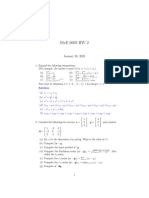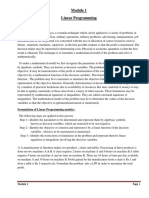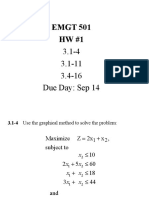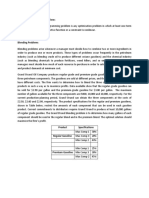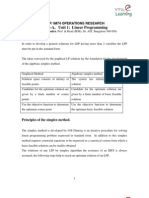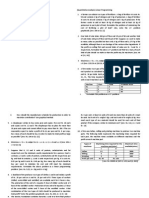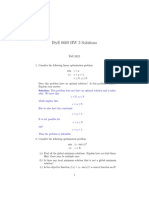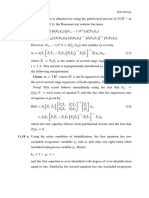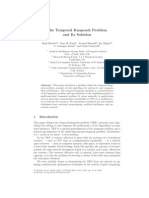Nonlinear Programming
Uploaded by
user2127Nonlinear Programming
Uploaded by
user2127Nonlinear programming
Nonlinear programming
In mathematics, nonlinear programming (NLP) is the process of solving an optimization problem defined by a system of equalities and inequalities, collectively termed constraints, over a set of unknown real variables, along with an objective function to be maximized or minimized, where some of the constraints or the objective function are nonlinear.[1] It is the sub-field of Mathematical optimization that deals with problems that are not linear.
Applicability
A typical nonconvex problem is that of optimising transportation costs by selection from a set of transportion methods, one or more of which exhibit economies of scale, with various connectivities and capacity constraints. An example would be petroleum product transport given a selection or combination of pipeline, rail tanker, road tanker, river barge, or coastal tankship. Owing to economic batch size the cost functions may have discontinuities in addition to smooth changes. Modern engineering practice involves much numerical optimization. Except in certain narrow but important cases such as passive electronic circuits, engineering problems are non-linear, and they are usually very complicated. In experimental science, some simple data analysis (such as fitting a spectrum with a sum of peaks of known location and shape but unknown magnitude) can be done with linear methods, but in general these problems, also, are non-linear. Typically, one has a theoretical model of the system under study with variable parameters in it and a model the experiment or experiments, which may also have unknown parameters. One tries to find a best fit numerically. In this case one often wants a measure of the precision of the result, as well as the best fit itself.
The general non-linear optimization problem (NLO)
The problem can be stated simply as: to maximize some variable such as product throughput or to minimize a cost function where
s.t. (subject to)
Nonlinear programming
Possible solutions
feasible, that is, for an optimal solution subject to constraints, the objective function is either is either maximized or or . minimized. unbounded, that it, for some subject to constraints, the objective function infeasible, that is, there is no solution that is subject to constraints.
Methods for solving the problem
If the objective function f is linear and the constrained space is a polytope, the problem is a linear programming problem, which may be solved using well known linear programming solutions. If the objective function is concave (maximization problem), or convex (minimization problem) and the constraint set is convex, then the program is called convex and general methods from convex optimization can be used in most cases. If the objective function is a ratio of a concave and a convex function (in the maximization case) and the constraints are convex, then the problem can be transformed to a convex optimization problem using fractional programming techniques. Several methods are available for solving nonconvex problems. One approach is to use special formulations of linear programming problems. Another method involves the use of branch and bound techniques, where the program is divided into subclasses to be solved with convex (minimization problem) or linear approximations that form a lower bound on the overall cost within the subdivision. With subsequent divisions, at some point an actual solution will be obtained whose cost is equal to the best lower bound obtained for any of the approximate solutions. This solution is optimal, although possibly not unique. The algorithm may also be stopped early, with the assurance that the best possible solution is within a tolerance from the best point found; such points are called -optimal. Terminating to -optimal points is typically necessary to ensure finite termination. This is especially useful for large, difficult problems and problems with uncertain costs or values where the uncertainty can be estimated with an appropriate reliability estimation. Under differentiability and constraint qualifications, the KarushKuhnTucker (KKT) conditions provide necessary conditions for a solution to be optimal. Under convexity, these conditions are also sufficient. If some of the functions are non-differentiable, subdifferential versions of KarushKuhnTucker (KKT) conditions are available.[2]
Nonlinear programming
Examples
2-dimensional example
A simple problem can be defined by the constraints x1 0 x2 0 x12 + x22 1 x12 + x22 2 with an objective function to be maximized f(x) = x1 + x2 where x = (x1, x2). Solve 2-D Problem [3].
The intersection of the line with the constrained space represents the solution
3-dimensional example
Another simple problem can be defined by the constraints x12 x22 + x32 2 x12 + x22 + x32 10 with an objective function to be maximized f(x) = x1x2 + x2x3 where x = (x1, x2, x3). Solve 3-D Problem [4].
References
[3] http:/ / apmonitor. com/ online/ view_pass. php?f=2d. apm
The intersection of the top surface with the constrained space in the center represents the solution
[4] http:/ / apmonitor. com/ online/ view_pass. php?f=3d. apm
Further reading
Avriel, Mordecai (2003). Nonlinear Programming: Analysis and Methods. Dover Publishing. ISBN 0-486-43227-0. Bazaraa, Mokhtar S. and Shetty, C. M. (1979). Nonlinear programming. Theory and algorithms. John Wiley & Sons. ISBN 0-471-78610-1. Bertsekas, Dimitri P. (1999). Nonlinear Programming: 2nd Edition. Athena Scientific. ISBN 1-886529-00-0. Bonnans, J.Frdric; Gilbert, J.Charles; Lemarchal, Claude; Sagastizbal, ClaudiaA. (2006). Numerical optimization: Theoretical and practical aspects (http://www.springer.com/mathematics/applications/book/ 978-3-540-35445-1). Universitext (Second revised ed. of translation of 1997 French ed.). Berlin: Springer-Verlag. pp.xiv+490. doi: 10.1007/978-3-540-35447-5 (http://dx.doi.org/10.1007/978-3-540-35447-5). ISBN3-540-35445-X. MR 2265882 (http://www.ams.org/mathscinet-getitem?mr=2265882).
Nonlinear programming Luenberger, David G.; Ye, Yinyu (2008). Linear and nonlinear programming. International Series in Operations Research & Management Science 116 (Third ed.). New York: Springer. pp.xiv+546. ISBN978-0-387-74502-2. MR 2423726 (http://www.ams.org/mathscinet-getitem?mr=2423726). Nocedal, Jorge and Wright, Stephen J. (1999). Numerical Optimization. Springer. ISBN 0-387-98793-2. Jan Brinkhuis and Vladimir Tikhomirov, 'Optimization: Insights and Applications', 2005, Princeton University Press
External links
Nonlinear programming FAQ (http://neos-guide.org/non-lp-faq) Mathematical Programming Glossary (http://glossary.computing.society.informs.org/) Nonlinear Programming Survey OR/MS Today (http://www.lionhrtpub.com/orms/surveys/nlp/nlp.html) Overview of Optimization in Industry (http://apmonitor.com/wiki/index.php/Main/Background)
Article Sources and Contributors
Article Sources and Contributors
Nonlinear programming Source: https://en.wikipedia.org/w/index.php?oldid=544442762 Contributors: Ajgorhoe, Alexander.mitsos, BarryList, Broom eater, Brunner7, Callanecc, Charles Matthews, David R. Ingham, Dmitrey, Dto, EconoPhysicist, EdJohnston, EncMstr, Frau Holle, FrenchIsAwesome, G.de.Lange, Garde, Giftlite, Headbomb, Hike395, Hu12, Isheden, Jamelan, Jaredwf, Jean-Charles.Gilbert, Jitse Niesen, Kiefer.Wolfowitz, KrakatoaKatie, Krishnavedala, Leonard G., MartinPoulter, McSush, Mcmlxxxi, Mdd, Metiscus, Miaow Miaow, Michael Hardy, Mike40033, Monkeyman, MrOllie, Myleslong, Nacopt, Oleg Alexandrov, Olegalexandrov, PimBeers, PiotrGregorczyk, Psvarbanov, RekishiEJ, Sabamo, Sbvb, Stevenj, Tgdwyer, User A1, Vgmddg, Xeltifon, 65 anonymous edits
Image Sources, Licenses and Contributors
Image:Nonlinear programming.svg Source: https://en.wikipedia.org/w/index.php?title=File:Nonlinear_programming.svg License: Creative Commons Zero Contributors: User:Krishnavedala Image:Nonlinear programming 3D.svg Source: https://en.wikipedia.org/w/index.php?title=File:Nonlinear_programming_3D.svg License: Public Domain Contributors: derivative work: McSush (talk) Nonlinear_programming_3D_jaredwf.png: Jaredwf
License
Creative Commons Attribution-Share Alike 3.0 Unported //creativecommons.org/licenses/by-sa/3.0/
You might also like
- Dangerous Google - Searching For Secrets PDF88% (26)Dangerous Google - Searching For Secrets PDF12 pages
- Download ebooks file The Volatility Edge in Options Trading New Technical Strategies for Investing in Unstable Markets 1st Edition Jeff Augen all chaptersNo ratings yetDownload ebooks file The Volatility Edge in Options Trading New Technical Strategies for Investing in Unstable Markets 1st Edition Jeff Augen all chapters55 pages
- David Amos, Dan Bader, Joanna Jablonski, Fletcher Heisler Python100% (15)David Amos, Dan Bader, Joanna Jablonski, Fletcher Heisler Python643 pages
- Understanding Database Types - by Alex XuNo ratings yetUnderstanding Database Types - by Alex Xu13 pages
- Policy Document Ucc Redemption Understanding The Process Further80% (20)Policy Document Ucc Redemption Understanding The Process Further37 pages
- Exercises For Aep: Part 1: Linear Algebra and Its ApplicationsNo ratings yetExercises For Aep: Part 1: Linear Algebra and Its Applications11 pages
- ENMG 616: Advanced Optimization Techniques (3 CR.) Course SyllabusNo ratings yetENMG 616: Advanced Optimization Techniques (3 CR.) Course Syllabus4 pages
- Dark Web Market Price Index Hacking Tools July 2018 Top10VPN291% (11)Dark Web Market Price Index Hacking Tools July 2018 Top10VPN27 pages
- Allison, Berkowitz - 2008 - SQL For Microsoft Access PDF100% (1)Allison, Berkowitz - 2008 - SQL For Microsoft Access PDF393 pages
- Chapter 3 - Introduction To Linear Programming ANo ratings yetChapter 3 - Introduction To Linear Programming A37 pages
- Mixed-Integer Linear Programming (MILP) - MATLAB IntlinprogNo ratings yetMixed-Integer Linear Programming (MILP) - MATLAB Intlinprog15 pages
- Exam Advanced Linear Programming, May 14, 13.30-16.30No ratings yetExam Advanced Linear Programming, May 14, 13.30-16.304 pages
- Stochastic Inventory Models: INOPER3 NotesNo ratings yetStochastic Inventory Models: INOPER3 Notes37 pages
- Object-Oriented Programming, Functional Programming and RNo ratings yetObject-Oriented Programming, Functional Programming and R14 pages
- Unit 2 Lecturer Notes of Linear Programming of or by DRNo ratings yetUnit 2 Lecturer Notes of Linear Programming of or by DR46 pages
- (Quantitative Analysis) Linear ProgrammingNo ratings yet(Quantitative Analysis) Linear Programming2 pages
- Training Design Phase: Facilitate The Learning or The Material and Its Transfer To The Job?No ratings yetTraining Design Phase: Facilitate The Learning or The Material and Its Transfer To The Job?18 pages
- A Family of Median Based Estimators in Simple Random SamplingNo ratings yetA Family of Median Based Estimators in Simple Random Sampling11 pages
- 10.4 Applications of Numerical Methods Applications of Gaussian Elimination With PivotingNo ratings yet10.4 Applications of Numerical Methods Applications of Gaussian Elimination With Pivoting11 pages
- Suresh Chandra - Fuzzy Linear Programming ProblemNo ratings yetSuresh Chandra - Fuzzy Linear Programming Problem76 pages
- The SIR Model When S (T) Is A Multi-Exponential Function.No ratings yetThe SIR Model When S (T) Is A Multi-Exponential Function.47 pages
- 04 - Inequalities and Linear Programming S1 2018-19100% (1)04 - Inequalities and Linear Programming S1 2018-1977 pages
- Chapter 9. Test of Hypotheses For A Single SampleNo ratings yetChapter 9. Test of Hypotheses For A Single Sample98 pages
- Additional Exercises For Convex Optimization PDFNo ratings yetAdditional Exercises For Convex Optimization PDF187 pages
- Linear and Multiobjective Programming With Fuzzy Stochastic ExtensionsNo ratings yetLinear and Multiobjective Programming With Fuzzy Stochastic Extensions103 pages
- Seminar On: Topic of Mathematical BiologyNo ratings yetSeminar On: Topic of Mathematical Biology40 pages
- Integer Programming Formulation ExamplesNo ratings yetInteger Programming Formulation Examples16 pages
- Statistics 131 Worksheet 10: Let X, · · ·, X ∼ U (0, θ), θ > 0. Find unbiased estimators of θNo ratings yetStatistics 131 Worksheet 10: Let X, · · ·, X ∼ U (0, θ), θ > 0. Find unbiased estimators of θ2 pages
- Limits and Continuity (Calculus) Engineering Entrance Exams Question BankFrom EverandLimits and Continuity (Calculus) Engineering Entrance Exams Question BankNo ratings yet
- Nonlinear Programming: Applicability Possible Types of Constraint Set Methods For Solving The Problem ExamplesNo ratings yetNonlinear Programming: Applicability Possible Types of Constraint Set Methods For Solving The Problem Examples4 pages
- School of Computer Science and Applied MathematicsNo ratings yetSchool of Computer Science and Applied Mathematics12 pages
- H78uithe Future of Global Ip - Unlock The True Potential of Your Ip PortfolioNo ratings yetH78uithe Future of Global Ip - Unlock The True Potential of Your Ip Portfolio15 pages
- How Blockchain Can Make Crowdfunding More Secure - Pledgecamp - MediumNo ratings yetHow Blockchain Can Make Crowdfunding More Secure - Pledgecamp - Medium3 pages
- 6844 Gig Economy and The Future of Work A Fiverr Com Case StudyNo ratings yet6844 Gig Economy and The Future of Work A Fiverr Com Case Study9 pages
- How Do State Universities Raise The Money Necessary For The Costs of Protecting Their Patents - QuoraNo ratings yetHow Do State Universities Raise The Money Necessary For The Costs of Protecting Their Patents - Quora6 pages
- Asset Securitization - How Remote Is Bankruptcy RemoteNo ratings yetAsset Securitization - How Remote Is Bankruptcy Remote25 pages
- Kalman Filter Explained - MOST SIMPLISTICALLYNo ratings yetKalman Filter Explained - MOST SIMPLISTICALLY100 pages
- MITOCW - MITRES - 6-007s11lec26 - 300k.mp4: ProfessorNo ratings yetMITOCW - MITRES - 6-007s11lec26 - 300k.mp4: Professor12 pages
- Global Base Metals Review: November, 2005No ratings yetGlobal Base Metals Review: November, 20053 pages
- OECD Communications Outlook 2011: Summary in EnglishNo ratings yetOECD Communications Outlook 2011: Summary in English5 pages
- Full download Network Security and Cryptography Sarhan M. Musa pdf docxNo ratings yetFull download Network Security and Cryptography Sarhan M. Musa pdf docx40 pages
- SFDSFD401 - Basics and Fundamentals of DatabaseNo ratings yetSFDSFD401 - Basics and Fundamentals of Database77 pages
- Metamodel Based Multidisciplinary Design Optimization For AutomotiveNo ratings yetMetamodel Based Multidisciplinary Design Optimization For Automotive132 pages
- Figuring The Population Bomb: Gender and Demography in The Mid-Twentieth Century100% (1)Figuring The Population Bomb: Gender and Demography in The Mid-Twentieth Century35 pages
- CTET - Syllabus: Structure and Content of SyllabusNo ratings yetCTET - Syllabus: Structure and Content of Syllabus18 pages
- The Temporal Knapsack Problem and Its SolutionNo ratings yetThe Temporal Knapsack Problem and Its Solution15 pages
- IIT-JAM Mathematics-Question-Analysis 05.07No ratings yetIIT-JAM Mathematics-Question-Analysis 05.072 pages












